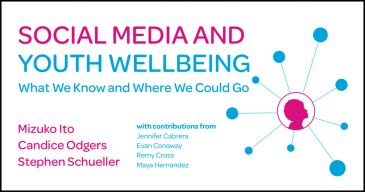
It’s interesting how much coronavirus has both distanced and gathered people. While we’re distanced physically, many have been connecting in online gathering places. Since April, I have joined video hangouts with five of my siblings and started sharing frequent updates in our new “family group chat”—although the last time we saw each other collectively in person was a few years ago. A group of friends who were inseparable in college, 20+ years ago, haven’t been together in more than a decade, but we’ve all crowded around our respective screens to marvel at how we all “look just the same” and to renew long-lost bonds. Meanwhile, my local book club and neighborhood Bunco group connected online to keep things as normal as possible after a brief hiatus.
These online connections are real. I felt joy at seeing my friends and sorrow at missing a few who were ill. Similarly, my teenage children have found support and friendship and a sense of normalcy as their online connections helped them maintain a sense of wellbeing despite the scary environment of a global pandemic. What my family and children experienced anecdotally has been examined by the Connected Learning Lab for the past year.

The group, led by Mizuko Ito, Candice Odgers, and Stephen Schueller, recently published their findings and recommendations in the position paper, Social Media and Youth Wellbeing: What We Know and Where We Could Go.
The team notes that the work underlying the paper was completed before the COVID-19 global pandemic; the results are even more compelling given the increased reliance on technology that we are experiencing right now. Like all of us, the researchers did not anticipate the seismic shift that would take place in expanding technology’s critical role in enabling work, learning, aid, play, and social connection.
Their review focuses on how teens support each other’s wellbeing through digital media during moments of stress and isolation. It summarizes current knowledge and suggests productive ways to continue the conversation about adolescent social media use and wellbeing.
Shifting Perspectives on Adolescent Social Media Use
Most people are aware that adolescents have been early and enthusiastic participants in online spaces, with teens in the United States spending nearly seven-and-one-half hours each day with digital entertainment media.
These high levels of engagement have sparked concerns about the relationship between digital device use and adolescent wellbeing, with heightened concerns around mental health. Some researchers have posited that adolescents’ high levels of adoption of social media are driving increases in mental health problems. These claims and related concerns have received widespread public attention. However, not only do systematic reviews of evidence in the health sciences not support these claims, they suggest that the accompanying fears are largely misplaced.
Ito, Odgers, and Schueller suggest three ways to shift the way that we look at adolescent social media use and wellbeing. These are particularly relevant in light of recent developments due to COVID-19.
1. Refocus the debate over the relationship between youth social media use and wellbeing to reflect evidence rather than hearsay, and emphasize differences based on varied youth perspectives and backgrounds. The authors point out that the simple question of whether more time spent using social media causes mental health problems in adolescents is unlikely to provide helpful insights. Instead, we can identify actionable knowledge by studying specific forms of social media engagement and whether they amplify or mitigate mental health risks for different adolescents.
2. Identify teen vulnerabilities and assets that may influence both healthy and problematic social media engagement. The team found that youth online interactions can promote wellbeing. Youth engage in a wide range of supportive behaviors online, including circulating supportive media content, promoting the visibility of oneself and others online, offering guidance to one another around difficult topics, and promoting a sense of community around marginalized interests and identities.
Evidence also indicates that young people are actively seeking support for mental health information online, and that they are using online tools to elicit social and emotional support.
On the other hand, online and offline vulnerabilities are interrelated. Negative online experiences such as negative comparisons or harassment are stratified by gender, socioeconomic status (SES), and race, and are tied to experiences of poverty, instability, and marginalization. This mirrors the experience of youth in the physical world.
3. Suggest opportunities through which youth social engagement might mitigate vulnerabilities and leverage assets. While there has been tremendous growth in efforts to leverage digital and networked technologies to support mental health, few are tailored to youth, and very few adolescents have adopted them.
Ito, Odgers, and Schueller suggest that digital mental health developers and providers be more responsive to youth needs by incorporating cognitive behavioral approaches, meeting youth in their spaces in digital communities, and working with online organizers and influencers to develop tools and training.
Additionally, it is important to focus extra efforts on youth who experience vulnerability because of social marginalization as described above; they potentially have the most to gain from digital connections with supportive peers and professionals.
Providing Mental Health Support for Teens
The report notes that we are still in the early stages of understanding how specific forms of social media use intersect with the activities of diverse youth and how these patterns of activities influence development and wellbeing.
However, it is clear that youth’s growing reliance on online support for mental health represents an opportunity for providers of mental health services, apps, and other supports. The team uncovered a significant gap between youth desire for mental health support, and what is being offered by digital mental health professionals.
Further Research Needed
When evaluating studies of risks, the team found an overwhelming focus on the volume of social media use rather than the nature and quality of use, as well as a lack of focus on specific types of online experiences or youth who are vulnerable to mental health problems.
The team calls on the community to collectively address these gaps and priorities with these actions:
- Perform and apply research focused on marginalized or underrepresented populations, such as Latinx and undocumented youth, Black youth, rural youth, and high-school age girls
- Integrate research on youth online communication with research on youth mental health
- Complete quantitative and qualitative evaluations differentiating between type of use or use of different platforms
- Move beyond the question of what is the relationship between social media and mental health to ask questions such as what types of social media use benefit or harm what types of people? When? and How?
- Design online mental interventions tailored to youth, addressing the gap between youth desire for mental health support, and what is being offered by digital mental health professionals
Next Steps Toward Youth Wellbeing
Social media is here to stay. Youth will benefit from an adult population that works to understand its current impacts and helps shape future uses. To that end, Ito, Odgers, and Schueller have looked across a range of relevant research and development efforts to identify gaps and opportunities in how to support adolescent wellbeing in the digitally networked world.
They see an urgent need to focus research, investment, and public attention on what actually drives and mitigates mental health problems for youth. They worry about the common but unsubstantiated assumption that social media is a negative influence, which has deflected attention from the real stressors that young people experience, including social marginalization, instability, and conflict. They also note that despite the rapid growth of digital mental health apps, the products do not address the unique needs and interests of youth.
The team suggests that mental health professionals, and society as a whole, work together to reach and support young people where they are—in social media platforms and online affinity groups.
Many youth and adults have turned to online and social media connections for interaction and support during the current pandemic, just as my family has. As we move ahead, it is crucial that the adult community of families, friends, researchers, developers, mental health professionals, and others, work together to understand and improve the options, so that youth are truly able to leverage social media for their wellbeing.
For deeper understanding, read about the Youth Connections for Wellbeing project.
 Claire LaBeaux oversees communications for several STEM and education-focused organizations. She works with the Connected Learning Lab to expand awareness of its research findings and to help people find applicable principles in the details. She earned a B.A. in Journalism and Mass Communications at San Jose State University.
Claire LaBeaux oversees communications for several STEM and education-focused organizations. She works with the Connected Learning Lab to expand awareness of its research findings and to help people find applicable principles in the details. She earned a B.A. in Journalism and Mass Communications at San Jose State University.


